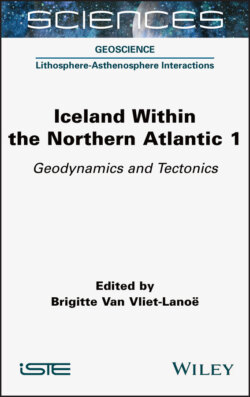Читать книгу Iceland Within the Northern Atlantic, Volume 1 - Группа авторов - Страница 14
1
Iceland, in the Lineage of Two Oceans
ОглавлениеBrigitte VAN VLIET-LANOË and Françoise BERGERAT with the collaboration of René MAURY, Hervé GUILLOU and Laurent GEOFFROY
There is no active region on Earth comparable to Iceland and its ocean environment (Figure 1.1). Situated in the Northeast Atlantic, Iceland is indeed located within a particularly complex geodynamic evolutionary domain, illustrating the problems inherent to the break-up of continents in the plate tectonic model, especially the recycling of ancient structures such as the suture of the Iapetus Ocean (section 3.2.2.3) and its paleoslab active during the Silurian. The latter has been mapped along the eastern coast of Greenland and is associated with calc-alkaline palaeo-volcanism (Andresen et al. 2007; Rhenström 2010).
The existence of Iceland probably dates back to the Oligocene. Its position east of Greenland and its insularization make it a key witness of the great changes controlling the evolution of the oceanic circulation. It has thus controlled the evolution of the climate since the Neogene, through the North Atlantic Current. It has also been, since 9 My, a key recorder of the onset of glaciation in the northern hemisphere, and also of glacier–volcanism interactions. Its location in the middle of the Greenland–Faroe Islands Ridge (GFIR) controls the descent of cold salty waters from the Arctic and North Atlantic into the thermohaline circulation section 3.4 of Volume 2).
Figure 1.1 summarizes the broad physiographic features and toponymy of the different structural domains (ridges and basins) of the North Atlantic and the Labrador-Baffin axis (LBA) on both sides of Greenland.
Figure 1.1. The Northeast Atlantic Ocean and the Labrador–Baffin axis (Gebco 2019 base, L. Gernigon processing)
These submerged domains are made up of lithospheres of oceanic and continental nature (section 3.2) with, sometimes, uncertain limits between these two types.
The emerged geology of Iceland shows a relatively recent differentiation. Large outcrops of so-called ancient basalts (15–5 My, in blue in Figure 1.2(b)) occupy coastal areas and are overlain by younger lavas (between 5 and 7 My, in green). This second generation of basalts is itself intersected by an active rift zone associated with Pleistocene (gray) and Holocene (pink) volcanism that crosses the whole island from south to north. In addition, four ice sheets cap presently the island in relation with especially wide brown bands (Figure 1.2(b)), which are the traces of subglacial volcanism, witnesses of a wider extension of the glaciers. It is also associated with a strong sedimentary splay along its southern coast (in light blue). Iceland has thus experienced a very complex history.
Figure 1.2. (a) Geological map of Iceland, originally at 1/600,000e (H. Johanesson 2014). Náttúrufræðistofnun Ísland (Icelandic Institute of Natural History) (available at: https://en.ni.is/resources/publications/maps/geological-maps)
Figure 1.2. (b) Simplified geological map of Iceland (Icelandic Geographical Institute/Landmælingar Ísland)
